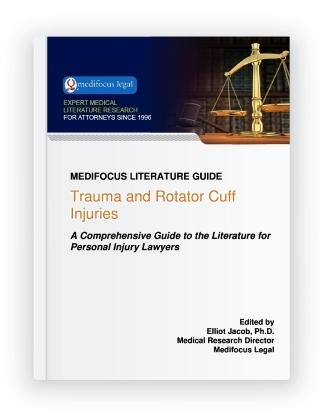Trauma and Rotator Cuff InjuriesA Comprehensive Guide to the Literature for Personal Injury Lawyers
Publisher: Medifocus Legal
Publication Date: August 21, 2018
Number of Pages: 166
A Comprehensive Guide to the Literature for Personal Injury Lawyers
Publisher: Medifocus LegalPublication Date: August 21, 2018
Number of Pages: 166
The two major causes of rotator cuff tears are degeneration associated with wear and tear of the normal aging process and acute trauma to the shoulder from accidental falls, contact sports, or motor vehicle accidents. Several retrospective studies on the etiology of rotator cuff tears have reported that between 40% and 70% of patients with rotator cuff tears have a history of trauma before developing shoulder complaints. This is of particular significance to personal injury lawyers who may be involved in litigating rotator cuff injury cases and who must often establish a causative link between a rotator cuff tear and the preceding trauma.
Tears of the rotator cuff are classified either as partial or incomplete tears or as full-thickness tears that result in separation of the tendon from the bone. Rotator cuff tears usually affect people in the middle age range and the area most frequently affected is the supraspinatus tendon.
The most frequent symptoms of a rotator cuff injury are pain, weakness, and limitation of motion. Studies have shown that traumatic lesions of the rotator cuff may often be missed because patients with no signs of a fracture or shoulder dislocation are usually released from an emergency room or doctor's office without further evaluation. Only much later, when the patient returns with ongoing symptoms of pain and disability, will further testing be performed. This may result in delayed treatment and can also influence the long term prognosis.
In general, the initial treatment of a partial rotator cuff tear is conservative and usually includes pain medications, physical therapy, exercise, and possibly injections of a local anesthetic or corticosteroids into the affected area. Surgery is an option for the management of a full-thickness tear that has been confirmed by an MRI scan, ultrasound, or arthroscopy. The decision to proceed with surgery depends on a variety of factors including the patient's age, occupation, level of physical activity, and overall health.
The MediFocus Literature Guide to Trauma and Rotator Cuff Injuries is a comprehensive reference guide that was developed to provide personal injury attorneys with a working knowledge of rotator cuff injuries with an emphasis on the role of acute trauma as a cause of these injuries. In addition, the Guide also focuses on the diagnosis, treatment, rehabilitation, and prognosis of both partial and full-thickness rotator cuff tears. The Guide contains over 170 journal article references with links to the article abstracts and also includes FREE online access to the full-text version of 26 articles.
 |
- A comprehensive bibliography of 217 journal article references indexed in MEDLINE published in well respected medical and scientific journals.
- Online access to the abstracts (summaries) of the articles.
- Online access to the free full-text version of 26 articles.
- Links to full-text sources of other articles that are available for purchase directly from individual journal publishers.
- A unique "Author Directory" consisting of the names and institutional affiliations of experts who have published and have specialized knowledge about Trauma and Rotator Cuff Injuries. The "Author Directory" is a valuable resource for quickly identifying and locating experts for case reviews, opinions, and testimony.
Select examples of topics that are covered by the articles referenced in this Guidebook include:
- Traumatic full-thickness transtendinous rotator cuff tears: a case series.
- Rehabilitation following surgical repair of the rotator cuff: a systematic review.
- Trauma versus no trauma: an analysis of the effect of tear mechanism on tendon healing in 1300 consecutive patients after arthroscopic rotator cuff repair.
- How to discriminate between acute traumatic and chronic degenerative rotator cuff lesions: an analysis of specific criteria on radiography and magnetic resonance imaging.
- Retear rate in the late postoperative period after arthroscopic rotator cuff repair.
- Prevalence of symptomatic rotator cuff ruptures after shoulder trauma: a prospective cohort study.
- Missed rotator cuff tears in polytraumatized patients.
- Rotator cuff injuries in professional and recreational athletes.
- Epidemiology, natural history, and indications for treatment of rotator cuff tears.
- Evaluation and treatment of rotator cuff tears.
- The diagnostic accuracy of MRI for the detection of partial- and full-thickness rotator cuff tears in adults.
- Functional recovery period after arthroscopic rotator cuff repair: is it predictable before surgery?
- Traumatic anterosuperior rotator cuff tears: the outcome of open surgical repair.
- Acute rotator cuff tear: do we miss the early diagnosis? A prospective study showing a high incidence of rotator cuff tears after shoulder trauma.
- Mid-term results and quantitative comparison of postoperative shoulder function in traumatic and non-traumatic rotator cuff tears.
- Diagnosis and treatment of rotator cuff tears in the emergency department.
- Acute traumatic tears of the rotator cuff: value of sonography.
is available in two formats: | |
Order by Phone:To order by phone, please call: Order by Mail:To order by mail, please print and complete this Order Form | |

